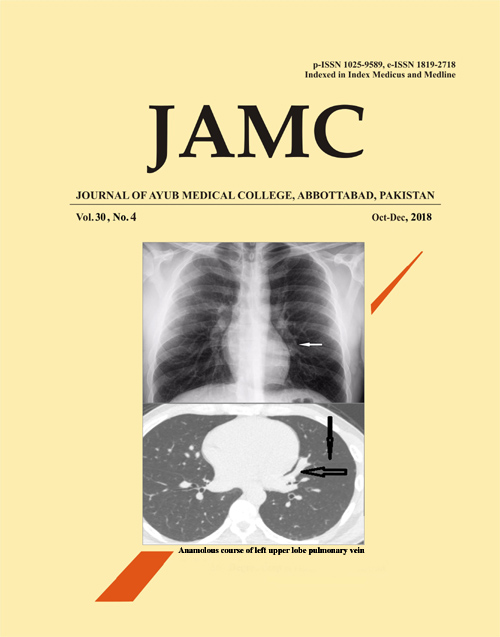COMPARISON OF OUTCOME OF 1- AND 2-KNOT, 4-STRAND, DOUBLE-MODIFIED KESSLER FLEXOR TENDON REPAIR WITH EARLY ACTIVE MOBILIZATION PROTOCOL IN PATIENTS WITH FLEXOR TENDON LACERATIONS OF HAND
Abstract
Background: Hand is unique for the dexterity of its function and flexor tendons have most important function in hand. Its injury is a challenging treatment. Purpose of this study is to compare the success of 1- and 2-knot, flexor tendon repair (good to excellent results) with early active mobilization in terms of total active motion (TAM) of affected hand postoperatively. Methods: Hundred patients with age range of 5-70 years of age presenting with flexor tendon lacerations of hand were included in the study. Subjects were randomly divided into Group A, who underwent flexor tendon repair using 4 strands of double modified Kessler repair with 1 knot and Group B, in which 4 strand double modified Kessler repair with 2 knot technique was used. All patients followed early active motion protocol started in first 48 hours. They were followed at 3, 6 and 8 weeks after surgery for TAM. Data was entered and analysed in SPSS ver: 21.0. Frequency and percentages were calculated for outcome of procedure. Results: In group A 89.8% (44) of patients had good to excellent results in terms of total active motion (TAM) as compared with 90.9% (40) in group B using early active mobilization protocol. Conclusion: The study concluded that that four strand double modified flexor tendon repair using either 1 or 2 knot technique are excellent choices of repair with early active mobilization protocols.
Keywords: Flexor tendon injuries; 4 strand repair; Total active motion; Early active mobilizationReferences
Ahmad M, Hussain SS, Tariq F, Rafiq Z, Khan MI, Malik SA. Flexor tendon injuries of hand: experience at Pakistan Institute of Medical Sciences, Islamabad, Pakistan. J Ayub Med Coll Abbottabad 2007;19(1):6-9.
Trumble TE, Vedder NB, Seiler JG 3rd, Hanel DP, Diao E, Pettrone S. Zone-II flexor tendon repair: a randomized prospective trial of active place-and-hold therapy compared with passive motion therapy. J Bone Joint Surg Am 2010;92(6):1381-9.
Saini N, Kundnani V, Patni P, Gupta S. Outcome of early active mobilization after flexor tendons repair in zones II-V in hand. Indian J Orthop 2010;44(3):314-21.
Kitis PT, Buker N, Kara IG. Comparison of two methods of controlled mobilisation of repaired flexor tendons in zone 2. Scand J Plast Reconstr Surg Hand Surg 2009;43(3):160-5.
Rees L, Matthews A, Masouros SD, Bull AM, Haywood R. Comparison of 1- and 2-knot, 4-strand, double-modified kessler tendon repairs in a porcine model. J Hand Surg Am 2009;34(4):705-9.
Wada A, Kubota H, Miyanishi K, Hatanaka H, Miura H, Iwamoto Y. Comparison of postoperative early active mobilization and immobilization in vivo utilizing a four-strand flexor tendon repair. J Hand Surg Br 2001;26(4):301-6.
Karlander LE, Berggren M, Larsson M, Soderberg G, Nylander G. Improved results in zone 2 flexor tendon injuries with a modified technique of immediate controlled mobilization. J Hand Surg Br 1993;18(1):26-30.
Buck-Gramcko D, Dietrich FE, Gogge S. Evaluation criteria in follow-up studies of flexor tendon therapy. Handchirurgie 1976;8(2):65-9.
Cullen KW, Tolhurst P, Lang D, Page RE. Flexor tendon repair in zone II followed by controlled active mobilization. J Hand Surg Br 1989;14(4):392-5.
Chow SP, Stephens MM, Ngai WK, So YC, Pun WK, Chu M, et al. A splint for controlled active motion after flexor tendon repair: Design, mechanical testing, and preliminary clinical results. J Hand Surg Am 1990;15(4):645-51.
Silfverskiold KL, May EJ, Tornvall AH. Tendon excursion after flexor tendon repair in zone II: Result with a new controlled motion program. J Hand Surg Am 1993;18(3):403-10.
Silfverskiold KL, May EJ, Tornvall AH. Flexor digitorum profundus tendon excursions during controlled motion after flexor tendon repair in zone II: a prospective clinical study. J Hand Surg Am 1992;17(1):122-31.
Hung LK, Pang KW, Yeung PL, Cheung L, Wong JM, Chan P. Active mobilisation after flexor tendon repair: comparison of results following injuries in zone 2 and other zones. J Orthop Surg (Hong Kong) 2005:13(2):158-63.
Downloads
Published
How to Cite
Issue
Section
License
Journal of Ayub Medical College, Abbottabad is an OPEN ACCESS JOURNAL which means that all content is FREELY available without charge to all users whether registered with the journal or not. The work published by J Ayub Med Coll Abbottabad is licensed and distributed under the creative commons License CC BY ND Attribution-NoDerivs. Material printed in this journal is OPEN to access, and are FREE for use in academic and research work with proper citation. J Ayub Med Coll Abbottabad accepts only original material for publication with the understanding that except for abstracts, no part of the data has been published or will be submitted for publication elsewhere before appearing in J Ayub Med Coll Abbottabad. The Editorial Board of J Ayub Med Coll Abbottabad makes every effort to ensure the accuracy and authenticity of material printed in J Ayub Med Coll Abbottabad. However, conclusions and statements expressed are views of the authors and do not reflect the opinion/policy of J Ayub Med Coll Abbottabad or the Editorial Board.
USERS are allowed to read, download, copy, distribute, print, search, or link to the full texts of the articles, or use them for any other lawful purpose, without asking prior permission from the publisher or the author. This is in accordance with the BOAI definition of open access.
AUTHORS retain the rights of free downloading/unlimited e-print of full text and sharing/disseminating the article without any restriction, by any means including twitter, scholarly collaboration networks such as ResearchGate, Academia.eu, and social media sites such as Twitter, LinkedIn, Google Scholar and any other professional or academic networking site.










